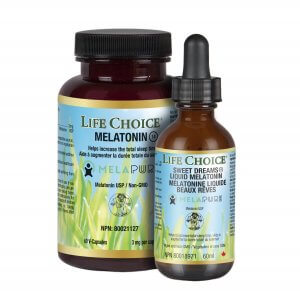One would assume that melatonin is melatonin, but that is clearly not the case.
Two forms of melatonin exist in the general market. One is the natural form which comes from the pineal gland of animals. It can be mixed with unknown synthetic material or unknown synthetic material free from animal tissues. Life Choice® Melapure® Melatonin uses a patented synthetic form following the same chemical pathway as natural melatonin; it is USP pharmaceutical grade and protected by a drug manufacturing file. Being a USP grade of
synthetic melatonin, it is safer to use because it is free from biological contaminants. Natural sourced melatonin, on the other hand, may pose a risk to humans because it can be contaminated with animal viruses.

Melatonin derived from unknown non-USP sources may cause side effects. The pineal gland is very sensitive, and melatonin is the hormone the pineal gland uses for producing serotonin. Do you think triggering such an important gland whose bodily functions control the sleep/wake cycle, reproductive development and target both the central and peripheral nervous system tissues should come from a source that is patented and secure? Can you imagine stimulating this gland with an animal pineal gland or animal mixed with unknown synthetic sources? It is no wonder why Chinese sources are associated with such radical side effects. As a price comparison, Chinese melatonin raw material is less than $200 per kg, while the raw material Life Choice® uses costs up to 700% more. What are the benefits of such expensive patented raw material? The benefits are twofold: first, the material is clinically tested and scientifically researched, and specifically used in dedicated clinical trials, and secondly, the quality is consistently high with each order. After the raw material testing stage, all our products are manufactured at third party GMP facilities, and then third party after product tested to ensure an arms-length distance at every manufacturing interval. We do everything in our power to ensure that the label matches the contents and to ensure that the product is therapeutic.
The price for this high quality raw material is worth every penny, as the patented USP material is used in all scientific research. Naturally-sourced melatonin that comes from the pineal gland of animals, and or mixed with unknown synthetic material may pose a risk to humans because it can be contaminated with animal viruses or environmental toxins. Synthetically-sourced, Melapure® Melatonin is safer to use because it is free from all biological contaminants. It is derived synthetically from 5-Methoxytryptamine; it is synthesized through a chemical pathway and produces a number of important chemicals, including serotonin, as intermediates. The patented formula takes a total of four reactions to bring about the change, and each of these reactions requires its own specific enzyme. One of these enzymes acts as the rate-limiting enzyme in the reaction pathway, and its activity determines how much melatonin is produced.
The rhythm or pathway for 5-methoxytryptamine that Melapure® Melatonin uses appears the same used for serotonin. The identification has been confirmed by analysis with gas chromatography–mass spectrometry. Although raw material sourcing is crucial—especially for melatonin—how the product is blended also impacts effectiveness. If we consider the active ingredient as being 3 mg, when encapsulated in the standard size “2” capsule, the total fill weight will be 370 mg with 367 mgs of fillers, and in tablets, the fillers are even more. If encapsulated in size “0,” the total fill weight would be 680 mg or 677 mg of filler. In perspective, a large pharmaceutical company would run a minimum of 100 million plus capsules, using 300 kgs of melatonin and 36,900 kgs of filler. It is perfectly understandable why each capsule is vastly different in the melatonin content, for blending equally is next to impossible. Life Choice® produces small batch runs of 133,000 capsules and encapsulate into size “4” vegetarian capsules with a total fill weight of 210 mg. This lower yield gives an equal distribution of melatonin per capsule.
If you have had bad experiences with melatonin, could it be because the melatonin was carelessly manufactured? Environmental toxins can affect the unstable molecule that releases melatonin from the pineal gland. Melatonin is a hormone, and because it is, hormones must be USP pharmaceutical grade. Otherwise, users run the risk of nightmares and other bad experiences. Have you tried our Melapure® Melatonin? Available in both capsule and liquid forms, every aspect of Melapure® Melatonin is made with the utmost care. If you are looking for a better melatonin experience, try Melapure® today.
For more information, visit: lifechoice.net
